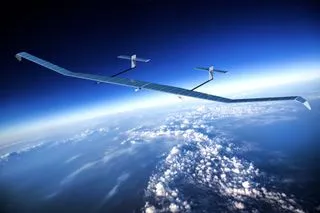The Zephyr : Introduction
Visualize a location where oxygen is scarce and wind speeds are negligible high above the clouds and weather limits. Such a place is called “stratosphere“, a part of the atmosphere that has not been completely tamed by humans. Here lies a creature known as Zephyr, which is both mysterious and strange-running counter to common sense.
The Zephyr is a solar-powered plane that can stay aloft for months at a time, flying at an altitude of 75,000 feet. It’s launched by hand, weighs just 75 kg, and travels at a leisurely 40 km/h. But what makes the Zephyr truly remarkable is its ability to stay in the stratosphere for extended periods, making it an ideal platform for a range of applications.

So, how does it work?
During the day, the sun hits the solar panels, charging the batteries and powering the propellers. As the sun sets, the batteries take over, and the plane slowly loses altitude. The trick is to ensure that the Zephyr remains above 60,000 feet by the time the sun rises again, allowing the process to start anew.
The Zephyr’s design has been fine-tuned to perfection, with every gram counting and every unit of battery density optimized. The precise curve of its “wings” is a marvel of engineering, allowing it to stay aloft for extended periods.
But why would anyone want a craft like the Zephyr?
The answer lies in its potential applications. Since Airbus spun off the new startup company, Alto, in 2023, the Zephyr has been pitched for Earth observation and as a flying base station for mobile phones. From the stratosphere, Zephyr can talk directly to a standard mobile phone, covering an area of approximately 72,000 square kilometers. This makes it an attractive solution for remote and rural areas, where traditional cell towers are expensive to maintain.
In the event of a natural disaster, Zephyr could be flown to an area that has been cut off from the grid, providing a vital lifeline for those affected. Mobile operators have something called “cell on wheels” (COW), which is usually a truck with equipment. Zephyr is like a “cell on wings,” a flying COW that can provide connectivity to areas in need.
Zephyr’s parent company has announced Kenya as the location of its first planned permanent launch site, and the company has spent a lot of time studying meteorology to understand how to transit through the tropopause safely.
While there are other ventures similar to the Zephyr, such as “Google’s Loon project“, which failed to stay afloat, the Zephyr’s unique combination of solar power and stratospheric flight makes it an attractive solution for a range of applications. Satellites, for example, can be put into orbit at a lower cost, but they can’t be brought down and swapped out with new payloads, and they can’t mimic the functionality of a terrestrial station.

The Zephyr represents a new frontier in high-altitude platform stations (HAPS), and it’s clear that there is both the appetite and the technology to fly high and stay high. Whether it’s for Earth observation, connectivity, or other applications, the Zephyr is a game-changer that could have a significant impact on our world.




